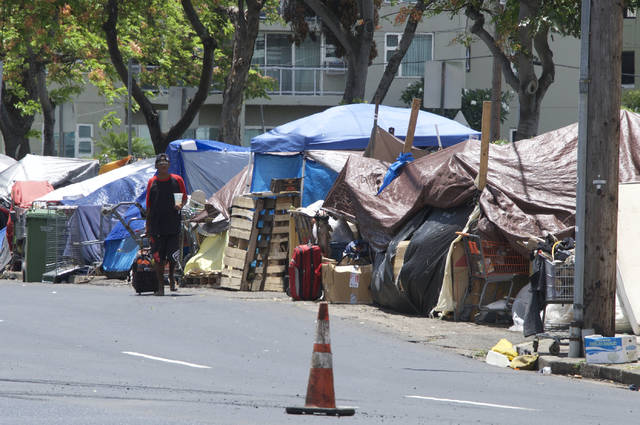Numbers of homeless questioned

CRAIG T. KOJIMA/ CKOJIMA@STARADVERTISER.COM
Homeless structures line Iwilei Rd to King St.
Looking around the disheveled homeless encampments on Oahu, it’s difficult to reconcile some of the more extraordinary numbers that came out of the latest homeless census last week — specifically, a 29 percent reduction in homelessness in Waikiki and East Honolulu.
If accurate, that would mean 129 fewer homeless people occupied Waikiki to Hawaii Kai in January compared with the year before.
Other than being geographic neighbors, the two communities have little in common that would suggest a reason for such a dramatic drop in homelessness between them.
Waikiki, Hawaii’s tourism mecca, was the first community to impose a sit-lie ban that has since been blamed for spreading homelessness into neighboring communities.
If Waikiki did see a big decline in homelessness from 2016 to 2017, where did all those people go?
East Honolulu has no sit-lie ban. As other communities have seen, Waikiki’s sit-lie ban could have pushed more homeless people next door into East Honolulu instead of contributing to a drop in one of Oahu’s most affluent regions.
Don't miss out on what's happening!
Stay in touch with breaking news, as it happens, conveniently in your email inbox. It's FREE!
The results of the annual, nationwide Point-in-Time Count do not break down the numbers between Waikiki and all of the communities that make up East Honolulu, and instead lump them together as one neighborhood.
Overall, the Point-in-Time Count showed just a 0.4 percent increase in homelessness on Oahu, or 19 more people — for a total homeless population of 4,959.
But Waikiki resident Paul Smith, who used to be homeless himself, sees little reduction in the number of homeless people he sees every day and speaks to regularly.
Smith said he offers his home as a place where homeless people can shower and get a sense of dignity.
If anything, Smith believes the numbers have grown in Waikiki — and possibly even farther east toward Hawaii Kai.
“The numbers that are being reported aren’t accurate,” Smith said. “We have a large stable of homeless people, and those numbers haven’t decreased at all. If anything, we’re seeing new faces.”
But there is one thing in common between the homeless in Waikiki and those in East Honolulu.
Smith serves on the board of Waikiki Health, which until this year provided outreach and mobile medical services to homeless people across the entire island, except the Waianae Coast.
Waikiki Health, its Care-A-Van and its staff of social workers also participated in the annual Point-in-Time Count for years until the organization lost its state contract that instead was awarded to the Institute for Human Services on Feb. 1.
In all, even without Waikiki Health, more than 500 volunteers helped count Oahu’s homeless over several days in January, Jen Stasch, director of Partners in Care, said last week in announcing the numbers.
Stasch and Partners in Care did not respond to requests for comment Monday.
Sheila Beckham, Waikiki Health’s CEO, said the 2017 volunteers did not have the benefit of Waikiki Health’s years of interactions with homeless people — or know where to find them so they could be counted.
“We had been doing outreach for 30 years,” Beckham said. “It took a lot of time to find the homeless encampments by climbing around and finding the caves. It took years of building trust. I’m not convinced that (the homeless numbers) improved that dramatically in Waikiki and the East Honolulu area.”
Asked whether she trusts the accuracy of the latest Point-in-Time Count numbers — especially for East Honolulu — Beckham said, “I definitely do not. We played such a major role for so many years in this Point-in-Time Count. (By not participating this year), that could have possibly influenced the numbers.”
State Rep. Gene Ward (R, Kalama Valley-Queen’s Gate-Hawaii Kai) helped create a homeless task force for East Honolulu and does contend the numbers have dropped in his district.
“I would generally say there’s been a lessening,” Ward said. “It’s generally taken a bit of a downturn. But we still have homeless at Safeway. We still have people talking to themselves at the bus stops.”
Ward also believes the loss of Waikiki Health in this year’s Point-in-Time Count hurt the count’s accuracy.
“I would say that Care-a-Van and Waikiki Health are really good data collectors,” Ward said. “The accuracy went down when they lost that contract.”
If East Honolulu indeed had 129 fewer homeless people this year, Ward has no idea where they went.
“We offered shelter to 100 percent of them, and almost 99 percent of them said, ‘Thanks but no thanks. Not interested,’” Ward said. “That seems to be standard procedure. Where have they gone? Sit-lie probably pushed them out of Waikiki.”
In November, Ward published a map of 11 locations where homeless people were believed to be living or hanging out in East Honolulu that the state attorney general later called legal and constitutional.
Ward maintains that homeless people may have heard “the word on the street” about Hawaii Kai: “It’s not a friendly place to go,” he said.
Ward called sit-lie “simply a palliative,” adding, “It’s a Band-Aid. It’s not really solving it (homelessness).”
Yet Ward argues Oahu should impose an islandwide sit-lie ban, even though he does not know where homeless people could then legally go — although he would want them to be allowed to live in tents and cars.
While the debate about sit-lie continues, Ward does agree that numbers showing a 29 percent drop in homelessness for Waikiki and East Honolulu do not seem to reflect reality.
“The numbers definitely went up overall,” Ward said. “I think they’re underreporting, quite frankly. Where did they go? If I was a homeless anthropologist, I’d probably say they went to another area where sit-lie encourages them … because we are still kicking the can down the road.”




